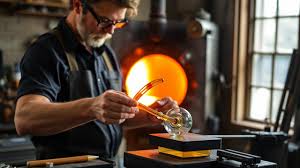Glassblowing is an ancient art form that combines creativity, skill, and science to shape molten glass into exquisite works of art. One of the most fascinating techniques in glassblowing involves the use of cane pickup plates and pastorelli—specialized tools and techniques that allow artisans to create intricate patterns and designs within glass. These methods have been practiced and perfected over centuries, and they remain vital to the creation of stunning glassworks today.
In this article, we will explore the history and significance of cane pickup plates, the role of the pastorelli, and how they are used to create breathtaking pieces that push the boundaries of this remarkable craft.
The History of Glassblowing and Cane Work
Glassblowing originated over 2,000 years ago in the Middle East and quickly spread throughout the Roman Empire, revolutionizing the way glass was crafted. Over the centuries, glassmakers developed increasingly complex techniques to enhance their creations, including cane work.
Cane work involves creating long, thin rods of glass (called “canes”) that are often infused with colored patterns or designs. These canes can then be incorporated into larger glass pieces to add intricate detail and visual interest. The use of cane pickup plates evolved as a way to efficiently arrange and fuse these delicate canes, enabling artisans to create consistent, elaborate patterns in their work.
What Is a Cane Pickup Plate?
A cane pickup plate is a tool used in glassblowing to arrange and organize glass canes for incorporation into a larger project. Typically made from metal or heat-resistant material, the plate allows the glassblower to lay out canes in a precise pattern before heating and fusing them together.
The process involves several steps:
- Preparation of the Canes: Glass canes are cut to the desired length and organized according to the intended design.
- Placement on the Pickup Plate: The canes are arranged side by side on the plate, ensuring they align perfectly to create seamless patterns.
- Heating and Fusing: The arranged canes are heated in a kiln or furnace until they fuse into a flat sheet of patterned glass, which can then be picked up and shaped further.
The cane pickup plate is essential for maintaining the precision and consistency of the design. It allows artisans to experiment with complex patterns, such as spirals, chevrons, or lattices, which would be nearly impossible to achieve freehand.
The Role of the Pastorelli
The pastorelli is another indispensable tool in the glassblowing process, particularly when working with cane pickup plates. This term refers to a rotating disk or plate that is mounted on a stand and used to support and shape the glass during various stages of production.
In the context of cane work, the pastorelli serves several key functions:
- Support During Pickup: Once the fused cane sheet is heated, the pastorelli provides a stable surface for picking up the sheet with a blowpipe or punty rod.
- Rotational Control: The rotating mechanism of the pastorelli allows the artisan to evenly distribute heat and pressure while shaping the glass, ensuring that the patterns remain intact.
- Versatility: The pastorelli can be adjusted to accommodate different sizes and shapes of glass, making it a versatile tool for a wide range of projects.
The combination of the cane pickup plate and pastorelli enables glassblowers to create intricate, high-quality designs with remarkable precision.
The Process of Creating Cane Work Using a Pickup Plate
- Design Planning
The process begins with meticulous planning. The artisan decides on the pattern and color scheme for the piece, selecting the appropriate canes for the design. - Arranging the Canes
The canes are carefully placed on the pickup plate, often requiring precision tools to ensure perfect alignment. The artisan must consider how the pattern will look when the glass is stretched, blown, or shaped. - Fusing the Canes
The arranged canes are heated in a kiln or furnace to fuse them into a solid sheet. This step requires precise control of temperature to avoid distortion or unwanted gaps in the pattern. - Pickup and Shaping
The fused sheet is picked up using a blowpipe or punty rod, often with the assistance of the pastorelli. As the glass is reheated and shaped, the artisan must carefully manipulate it to preserve the integrity of the pattern. - Final Shaping and Finishing
The glass is blown, stretched, or molded into its final form. Whether it becomes a vase, bowl, or sculpture, the intricate cane patterns add depth and character to the finished piece.
Applications and Aesthetic Appeal
Glassworks created with cane pickup plates and pastorelli are highly prized for their artistic and technical complexity. This technique is commonly used to produce:
- Decorative Vessels: Bowls, vases, and plates featuring mesmerizing patterns.
- Artistic Sculptures: Intricate designs incorporated into abstract or figurative forms.
- Lighting Fixtures: Chandeliers and lampshades that play with light and color.
The aesthetic appeal of cane work lies in its ability to create optical illusions, vibrant color contrasts, and geometric harmony. Every piece is a testament to the artisan’s skill and creativity.
The Challenges and Rewards of Cane Work
Working with cane pickup plates and pastorelli requires immense patience, precision, and expertise. The process is labor-intensive, and even a small mistake can compromise the entire design. However, for those who master the technique, the rewards are immense. The resulting glass pieces are not only visually stunning but also rich in cultural and artistic significance.
Conclusion
The use of cane pickup plates and pastorelli represents the intersection of tradition and innovation in glassblowing. These tools empower artisans to create intricate, patterned glassworks that captivate the imagination and stand as timeless examples of human creativity.
Whether you are a seasoned glassblower or a curious enthusiast, exploring the art of cane work offers a deeper appreciation for the craftsmanship and ingenuity behind each piece. It is a celebration of precision, beauty, and the enduring legacy of glassblowing as an art form.

